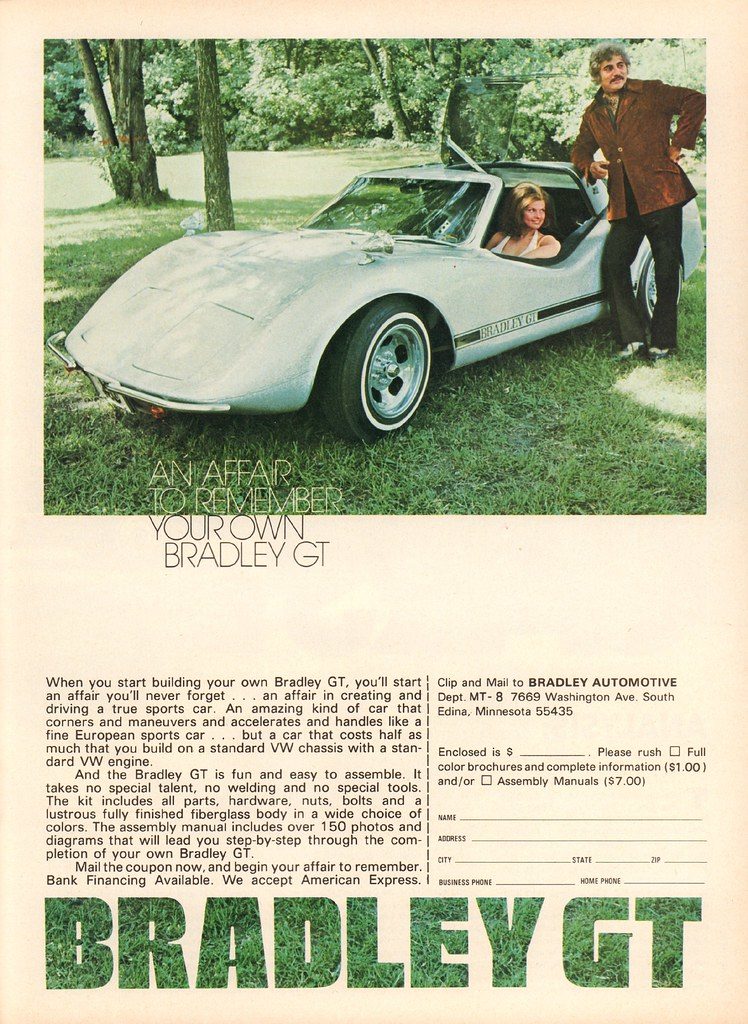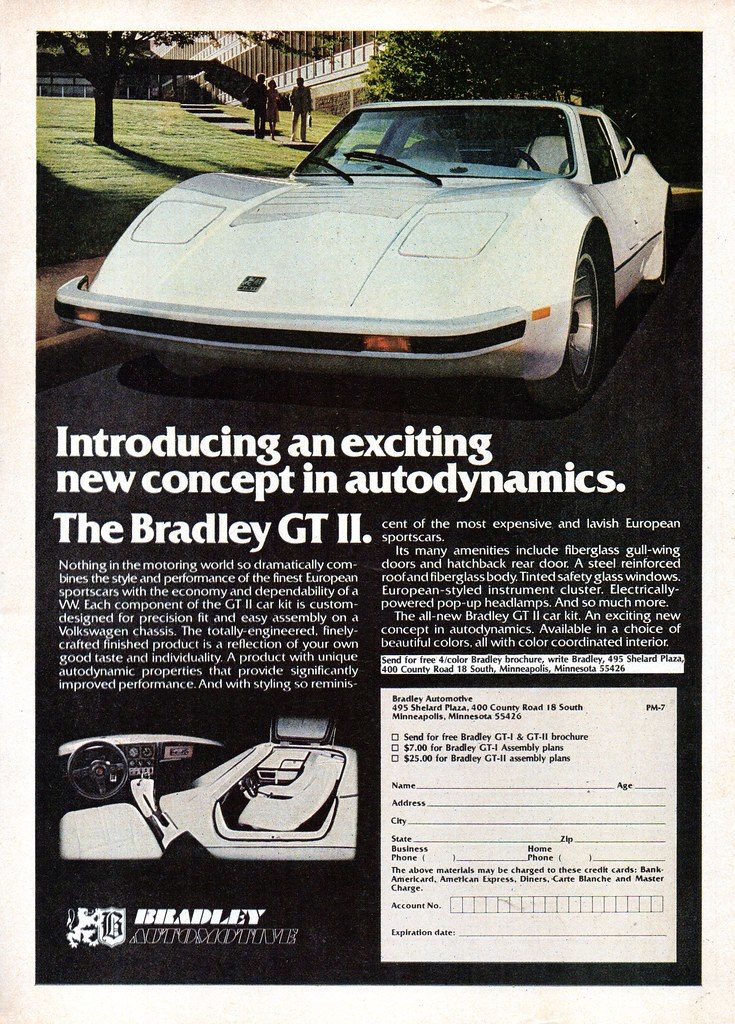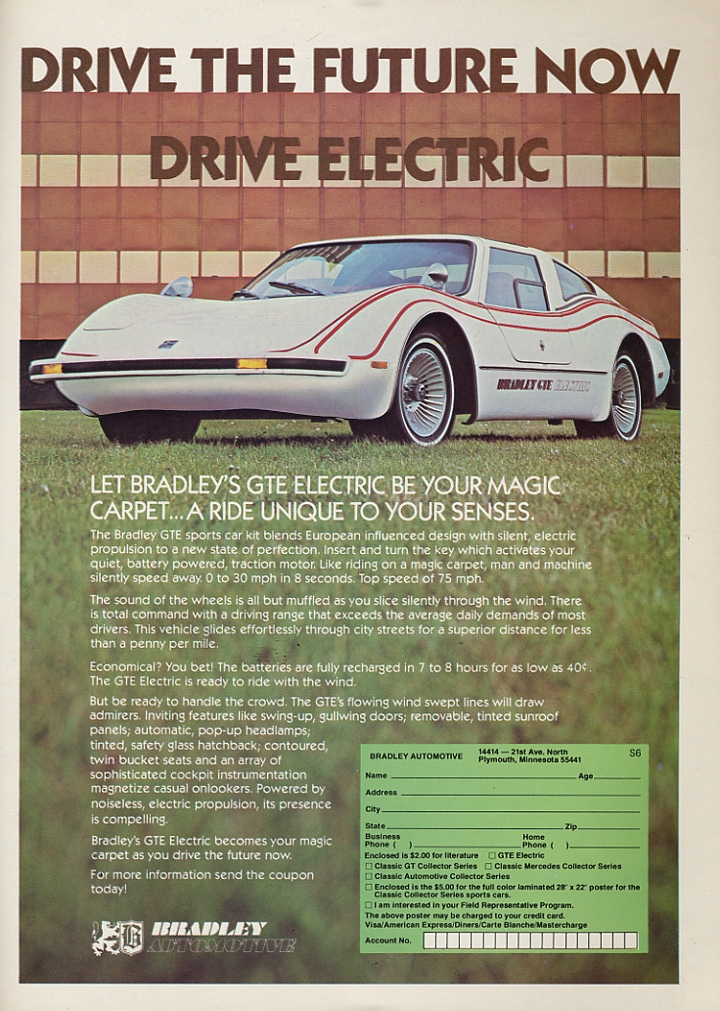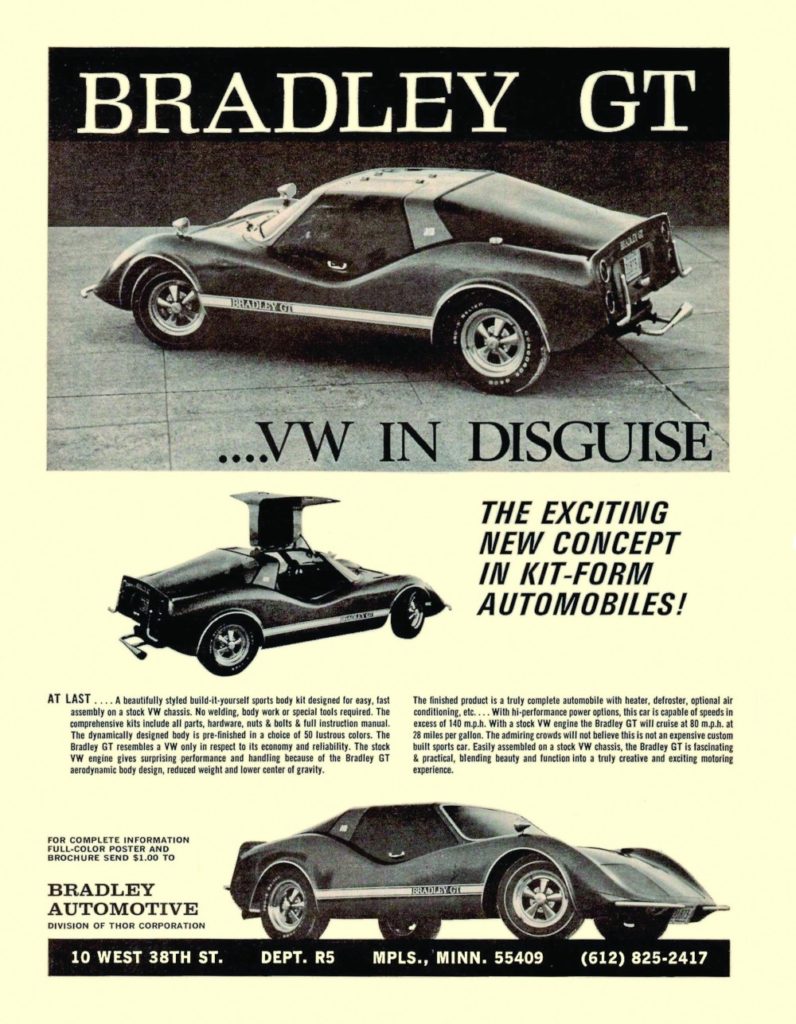GT

The GT was the first product sold under the Bradley Automotive name. The car’s development was extremely informal, and the cost for prototyping materials was estimated to only have been US$2000. According to the Bradley newsletter the first production GT was delivered in September 1970. The car was available in kit form in different levels of completeness, or as an assembled vehicle. A completed GT weighed approximately 1,600 lb (725.7 kg).
The GT’s body was a two-seat coupe with low curved sides and no doors. Weather protection was provided by two frameless plastic panels that extended into the roof and hinged up gull-wing style. Hidden headlamps were mounted under two large opaque covers.
The body was laid up in fiberglass and designed to mount on an unmodified Volkswagen Beetle chassis. The GT thus inherited its 2,400 mm (94.5 in) wheelbase from the donor vehicle, while front and rear tracks could vary depending on the builder’s choice of wheels and tires. Suspension front and rear was via the VW’s transverse torsion bars and trailing arms. The default power-train was likewise the air-cooled four-cylinder boxer engine and four-speed manual transmission with swing axles from the donor Beetle.
The GT incorporated many parts from other cars built in larger volumes. The windshield, for example, was from the 1963-1967 Corvette. One consequence of this reuse of common parts is that many parts for the GT remain in plentiful supply.
Due to the car’s do-it-yourself nature there was considerable variation between finished vehicles. Some GTs replaced their hidden headlamps with fixed headlamps under transparent covers. Bradley offered the back window in three variations; a short three-sided piece, a longer fastback piece that extended back to the base of the rear spoiler, or an extended wagon-back rear cover. The power output or even type of engine could also vary widely, depending on the owner/builder’s wishes.
The Bradley GT was in production from 1970 to 1981. The total number of Bradley GTs produced is estimated to have been 6000 cars.
GT II

In 1975 industrial designer and former Shelby American employee John Chun designed a new car for Bradley that would be called the Bradley GT II.
The GT II was described as a “Luxury Sports Car Kit” in its knock-down form, although it could be had as a turn-key car as well. Even though still based on a VW Beetle chassis, the GT II was a much more sophisticated vehicle than the earlier GT. New features included true gull-wings doors with frames, sliding safety glass in the doors and interior door releases with gas struts, a lower sill to ease ingress and egress, improved bumpers and steel reinforcing in the roof. The retractable headlamps were now electrically driven. The interior was much roomier, with custom seats able to comfortably accommodate passengers over 6 feet in height. Instrumentation was provided by a set of VDO Jet Cockpit gauges.
Development of the GT II cost approximately US$1,000,000. The GT II was finally released in November 1976. The car was later offered in one Special edition; the Solid Gold Series 14000 G Limited Edition. The GT II would also become the basis for Bradley’s electric GTE.
A total of 500 GT II cars are believed to have been built. Today this Bradley model suffers from a scarcity of GT II-specific parts such as window glass, upholstery and fiberglass body components.
GTE

In 1980 Bradley released a version of the GT II powered by a battery bank driving an electric motor. This model was at first called the GTElectric. The name soon became the GTE Electric and then simply the GTE.
The car was developed with the assistance of General Electric’s Electric Vehicle Systems Operation (EVSO). GE supplied the car’s Tracer I direct-traction motor, which developed 20.7 horsepower (15.4 kW) and was installed in place of the original VW engine. GE also supplied an EV-1 motor controller.
The main battery bank was made up of 16 6-volt batteries connected in series for a total of 96 volts. A switch inside the car allowed the driver to switch from `Boost’ mode, which delivered the full 96 volts to the motor for extra power, to `Cruise’ mode, which reduced motor voltage to 48 volts and extended the driving range. The 17th battery was a 12-volt unit used to run accessories like headlamps and windshield wipers. With the batteries installed the car weighed about 2,900 lb (1,315.4 kg). The original VW suspension was retained, but overload shock absorbers were installed to handle the extra weight.
Top speed was over 75 mph (120.7 km/h) in Boost mode, and 55 mph (88.5 km/h) in Cruise mode. On Boost the car accelerated from 0-30 mph in 8 seconds.
A total of 50 GTEs were built. The all-electric conversion developed for the GTE was to be applied to the rest of Bradley’s (now EVC’s) product line.
Derivatives and successors

During the years that the Bradley GT was in production some competing cars appeared that were not Bradleys but that were clearly at least partial copies.
One such car was the Scorpion GT sold by VW/GT Conversions in the early to mid-1970s. The Scorpion’s body was nearly indistinguishable from the Bradley GT from the A-pillar back, but the front was reshaped with a center power bulge, a larger grille opening and a single round exposed headlamp faired into each side of the nose. The Scorpion’s roof had a removable panel that allowed it to be used as a targa top.
Another car that mimicked the looks of the Bradley GT was the Lithia GT. This car had a body and roof structure that closely resembled the GT’s from the A-pillar back but with a slim air intake in front and a single round exposed headlamp integrated into each front fender.
After Bradley Automotive went out of business the molds and rights for the Bradley GT were sold to SunRay Products, who put the original GT back into production. Sun Ray also developed a “Sport Pack” body kit that gave the car a ground-effect look and added a rear engine cover that lifted up.
Source: https://en.wikipedia.org/wiki/Bradley_Automotive
